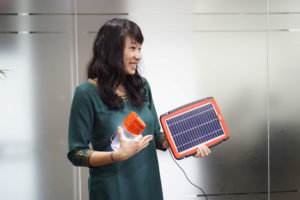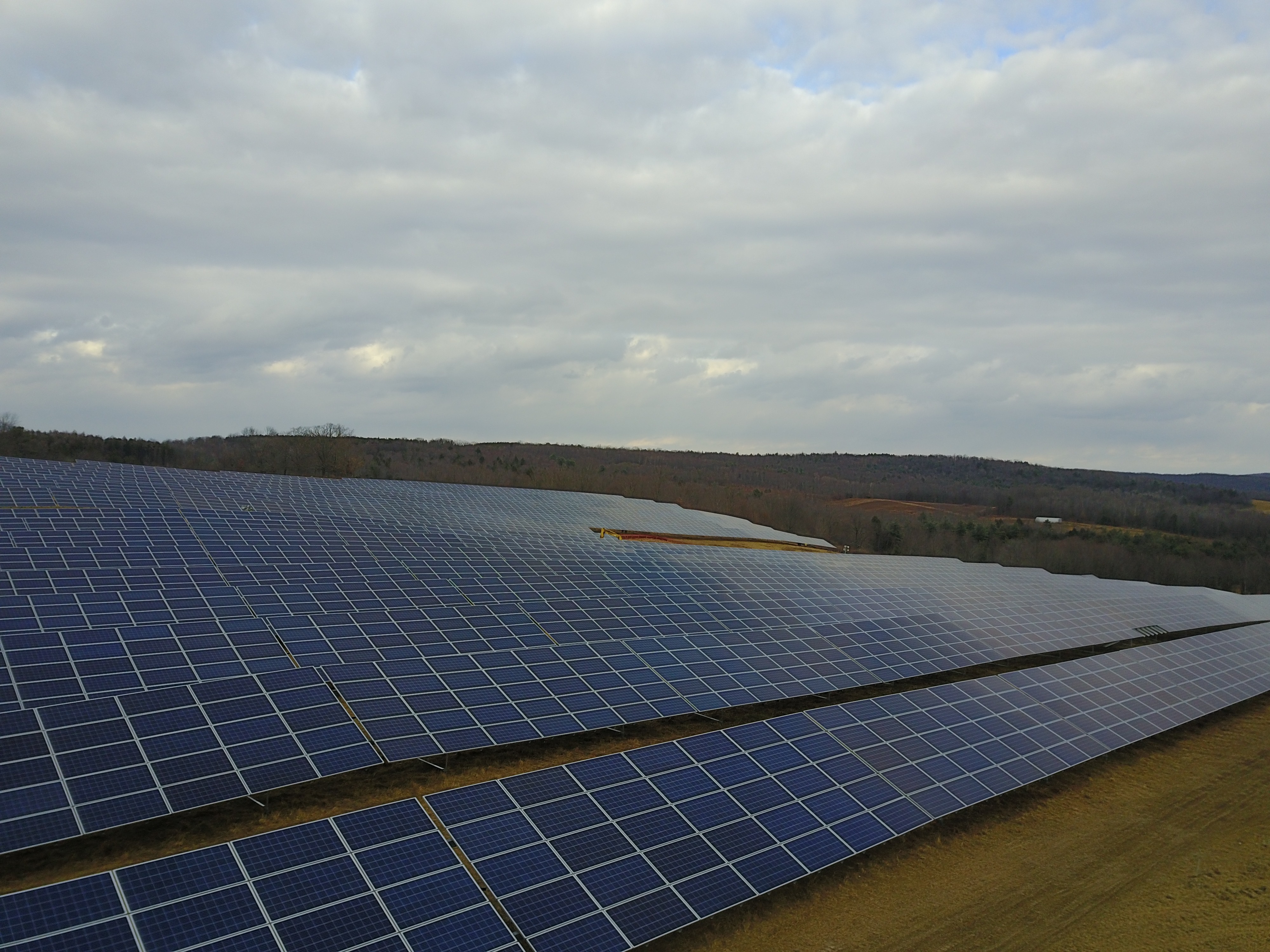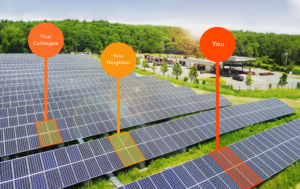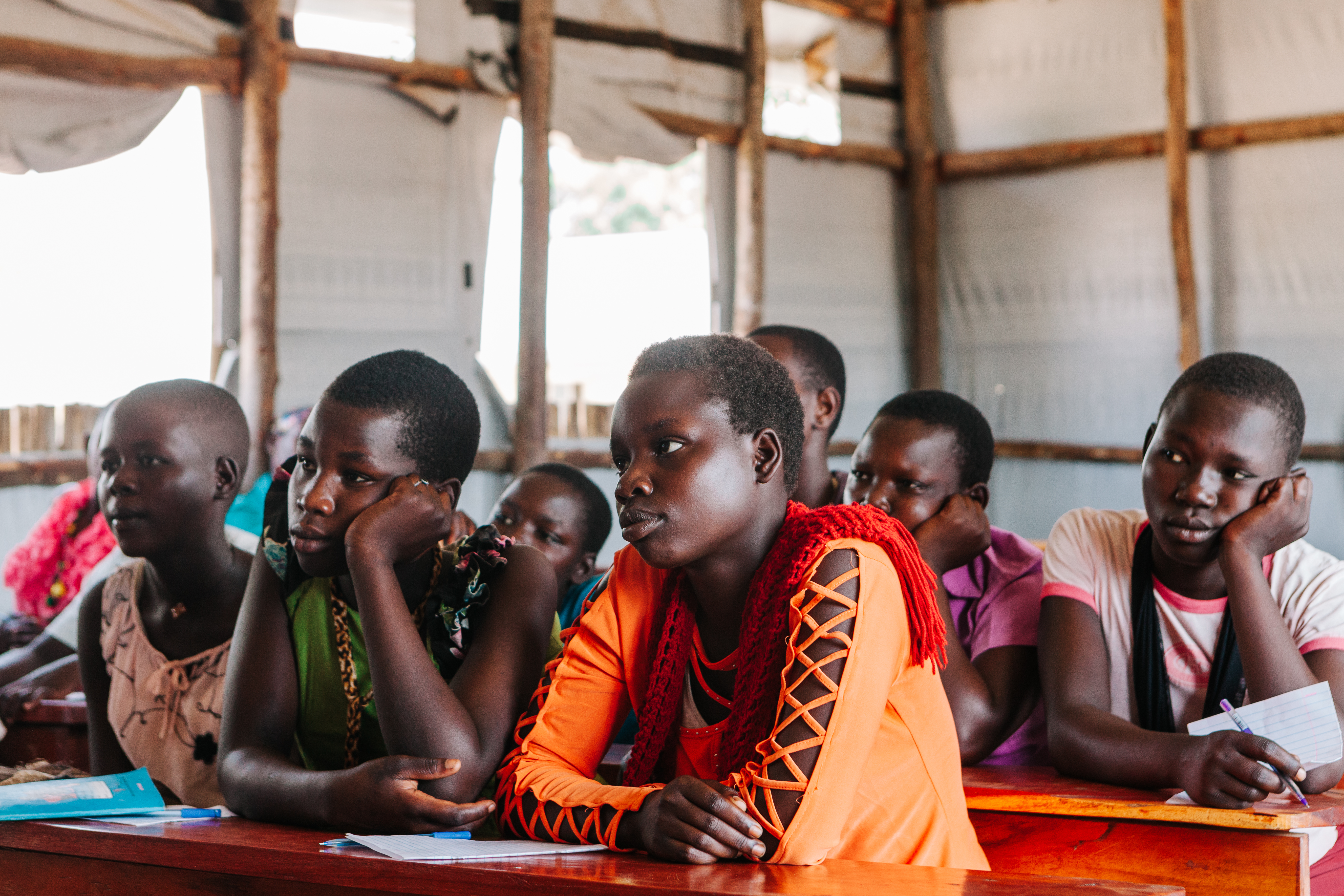Innovation and Community-Shared Solar Power Are Key to Reducing Energy Poverty in Developed Grid Contexts
Since 2012, every year 100 million people have gained access to electricity, most for the first time. With the cheapest energy in 60 countries coming from solar panels, and wind energy hitting record low prices, there is little question that clean energy will continue to play an increasing role in the life of a new generation.
While the vast majority of individuals still living without power are in countries with less developed electricity grids, the problem of clean energy access persists in more historically developed contexts. In recent years, Spain and other OECD (Organisation of Economic Co-operation and Development) countries have experienced unrest over energy access issues, especially after the UN reported in 2014 that energy poverty led to the premature death of up to 10,000 people yearly in Spain alone.
IN THE PHOTO: “End light shut-offs” A flyer hangs on a community announcement board in Barcelona, advertising a march to protest the effects of energy poverty PHOTO CREDIT: Forrest Watkins
Moreover, in jurisdictions where local policy allows households to save on their electricity costs by installing solar panels on their property, low-income households tend to be disproportionately left out. In the U.S., 40 percent of households earning less than $40,000 per year make up less than 5 percent of residential solar installations.
A variety of tools now seek to address this inequity and to bring about more universal access to sustainable energy. Scalable models such as targeted state programs, innovative solar financing mechanisms, and community-shared solar arrays are already bringing clean energy access to households that were previously excluded – and their impact is projected to grow.
Clean Energy for All: A Call for Equitable Energy Outcomes
Our energy systems have never been equitable in their distribution of costs and benefits. One of the starkest indicators of this inequity is the disproportionate impact of pollution on low-income communities and communities of colour. Countries with lower median income levels experience the brunt of the air pollution that kills 9 million people each year, and this phenomenon is mirrored in OECD countries.
Marginalised communities, including low-income communities and communities of colour, have to deal with higher incidences of dangerous air pollution, such as those produced by diesel engines, power plants, and refineries.
Living in areas with more pollution has direct effects on these communities’ health and well-being. Black American children are twice as likely to die from an asthma attack as White American children, and Black Americans are both less likely to smoke and more likely to die of lung disease than White ones.
A 2017 study from the Spatial Economics Research Centre suggests that the segregated effects of pollution stretch back at least to the advent of industrial energy systems. Wondering why so many poorer neighbourhoods are located on the eastern ends of world cities, researchers investigated the flow of air pollution from 5,000 industrial chimneys in computer models of 70 English cities as they existed in 1880. They found that residents of the eastern ends of these cities would have experienced disproportionate pollution, and postulated that this could have been a key driver of the spatial income divisions that we see today.
Unequal access to energy systems also follows racial, geographic, and class-based divisions. The installation of lighting systems has historically lagged in poor and rural areas, with corresponding implications for human health and social mobility. This can be seen both in 1930s rural electrification efforts by American entities such as the Tennessee Valley Authority and in contemporary fights to increase electricity access in poor and remote regions of developing countries.
Electricity access has long been fraught for low-income urbanites, as well. The problem of “energy poverty” gained particular prominence in Europe in the wake of the 2008 financial crisis. The concept has a variety of framings and definitions, but Vasileios Ntouros of the Group of Building Environmental Research at the University of Athens points to two key statistics in a recent report:
- 54 million Europeans can’t afford to heat their homes during the winter;
- At least half of Europeans spend more than 10 percent of their income on energy
A 2016 study of American energy poverty revealed that low-income households spend three times as much of their income on energy compared to non-low-income households and that African-American and Latino households each spend more than White households. Moreover, the inaccessibility of new, more energy-efficient appliances and building materials means that, when adjusted to the size of the home, many low-income Americans actually spend more on energy in absolute terms.
Behind these numbers are hard decisions. Energy-poor families are put in the position of having to choose between basic necessities such as water, food, heating, and light; uncertainty is introduced into their financial planning by fluctuating and periodic billing; and they experience threats to their health and increased mortality, especially among elderly and other vulnerable populations.
Universal energy access is thus a chance to break with the industry’s long history of exclusion and marginalisation, and to ensure more equitable outcomes in health, opportunity, and agency. Keeping in mind the impact of polluting energy sources and high energy prices, it becomes clear that energy access will only be universal when it is both affordable, such that every household can comfortably cover their basic energy needs, and clean, such that no individual or government has to choose between health and opportunity.
Clean Energy Access in the Context of a Developed Grid
Countries with high levels of infrastructure development pose unique challenges to increasing equity in clean energy access. A rapidly increasing proportion of new energy access in less-developed grid contexts comes from renewable energy systems that operate independently from the regional electric grid, a development made possible by innovative financing and pay-as-you-go payment plans. Depending on their size and energy storage capacity, these “microgrids” may provide enough electricity to power lighting systems and charge cell phones for a single house, or provide for the needs of a whole neighbourhood.

IN THE PHOTO: A solar farm near Elmira, NY built by Delaware River Solar in collaboration with Solstice.. PHOTO CREDIT: Solstice
Unfortunately, the sheer of energy usage by middle-to-high income households put current microgrid technologies out of the realm of practicability. Moreover, existing grid infrastructure was built to incorporate a handful of large power generation plants rather than thousands of distributed sources, and additional charges can drive the cost of installing renewables beyond the reach of many households.
So, what is the best way to bring universal access to affordable, renewable energy? Countries with strong public support for both low-carbon, low-pollution energy and a strong social safety net have shown in recent years that the most efficient path to large-scale renewable energy deployment may be driven by state mandates. Sweden, for example, is one of the leading countries in terms of overall renewable energy production, with 57 percent of 2017 electricity consumption coming from renewable sources such as wind and hydropower, and a goal of 100 percent renewable energy by 2040. It has shown similar leadership in combating energy poverty, with the lowest 20 percent of incomes spending only 3.6 percent of their income on energy costs (as previously noted, half of Europeans dedicate more than 10 percent of their income to energy).
These developments have been made possible by ambitious policies such as a 1991 carbon tax, strong incentives for the weatherisation of homes, and requirements to include heating costs in rent and maintain a minimum temperature in homes.
In contrast, U.S. climate politics continue to be thorny, at least at a national level, and constituencies expressing unconditional opposition to taxes and mandates are strong. In this context, local politics have largely determined the success of efforts to expand renewable energy deployment.
Many of the U.S. states that have seen higher rates of renewable energy deployment have policy frameworks that mirror their European counterparts, including renewable energy mandates and local carbon taxes. California, for example, has a per-capita solar capacity rivalling Germany (its geographic position puts its actual yearly generation well above Germany’s), with approximately 20,100 MW installed over 750,000 separate installations. Other sunny states leave a marked contrast: Alabama, for example, has been noted for its lack of supportive state policies for solar and has only 129 MW installed over 88 installations.
What next?
Policies supporting generalised renewable energy deployment are clearly important to scaling renewable energy in developed-grid contexts. It is important, though, to acknowledge that deployment is a step removed from the sustainable development goal of universal clean energy access. Developing renewable energy projects that are driven and owned by private citizens and businesses is not only the most direct path to renewable energy access but can provide important benefits to our electric grids.
As of December 2016, approximately 40 percent of installed U.S. solar capacity came from small-scale or distributed (residential, commercial, and industrial) sources. While distributed resources make up a significant portion of today’s solar market, though, installations are hobbled by structural barriers that exclude nearly 80 percent of American households from installing rooftop solar. Overcoming these barriers will be key to accelerating the global transition to renewable energy.
Moreover, those excluded are disproportionately low-income communities and communities of colour. Given that incentive programs typically bring long-run cost savings to participants, this disparity poses a key challenge to achieving universal access to affordable, clean energy.
Financial Barriers Define Residential Solar Exclusion
Several factors define households’ inability to participate in rooftop solar programs, many of them closely linked to social class.
At a basic level, most households seeking to install rooftop solar need a south- or west-facing roof that is strong enough to support the panels and free of shade during peak hours; these requirements immediately exclude residents of multi-family housing from full clean energy access.
Even for individuals who are able to secure access to their rooftop, there is rarely enough suitable roof space to supply all of the energy needs of a multi-family housing complex. And in countries like the United States, where renters typically pay their own energy bills, the households face an additional barrier in that most property owners will have no financial incentive to invest in a rooftop array (tenants themselves typically don’t stay in the same home for long enough to see a return on investment).
Financial barriers provide further limitations to equitable participation in distributed solar energy programs. Despite dramatic price declines, an average rooftop solar array has an upfront cost of approximately $20,000 and may take up to 15 years to pay for itself, excluding populations with lower incomes and less accumulated wealth.
Financing options are increasingly available for homeowners interested in installing rooftop arrays, but nevertheless, reinforce equity issues in renewable energy access. Solar loans and leases are most often based either on homeownership or FICO credit scores. As with renters, individuals with low credit scores, or who lack credit scores, are disproportionately low-income and people of colour.
From homeownership status to credit score, significant challenges confront any individual looking to access affordable, clean energy. Fortunately, groups around the world are working to address them and bring about a more equitable and sustainable energy system.
Policymakers and Entrepreneurs Drive Progress on Access to Affordable, Clean Energy
The challenge of increasing access to renewable energy has spawned unlikely partnerships between government, business, academia, and the non-profit world.
Within the confines of rooftop solar, advocates have pushed for and implemented programs to bring favourable financing to low-income households and solar access to public and affordable housing.
Mortgage-backed loans for rooftop solar arrays (modelled on similar home improvement loans) have become a common offering for banks and mortgage companies, and offer relatively favourable rates to many customers. Unfortunately, says Professor Daniel Kammen of the University of California, Berkeley, high-income households are able to get better rates on such loans.
It was this disparity that led Cisco DeVries, now CEO of Renew Financial (of which Kammen is also a founder), to originate Property-Assisted Clean Energy (PACE) financing. In this model, governments offer financing for renewable energy installations and energy-saving retrofits to properties in their jurisdiction. These loans are then paid back on the owner’s property tax. According to Kammen the principal benefit of this model, besides the relatively affordable rates, is the fact that it makes solar and energy efficiency improvements into standardised and easily comprehensible products, encouraging households to make energy efficiency improvements at the same time that they install solar.
PACE-enabling legislation has since been passed in 31 states, and locally implemented programs have been shown to have a significant impact on renewable energy deployment.
While there is room to improve consumer protections and better align federal and local policies, Kammen says the main barriers to scale are “Program awareness… [and] getting the payments to be superior to mortgages.”
With the European Commission awarding PACE provider Global New Energy Finance €2.4 million to bring PACE to Europe, this mechanism may provide fuel for regional renewable energy and energy efficiency goals.
Solutions for Low-Income Communities
Both state and private actors have targeted affordable housing projects as a direct path to increasing clean energy access for low-income communities. One prominent example of this is California’s Single-family Affordable Solar Homes (SASH) program, which provides greater incentives for solar installations on single-family affordable homes. Administered by GRID Alternatives, a non-profit solar installer set up to provide low- or no-cost solar to income-qualified households, the program has so far funded more than 9,000 systems totalling 32.4 MW of solar capacity.

IN THE PHOTO: An aerial view of Delaware River Solar’s first completed community solar project in Callicoon, NY. PHOTO CREDIT: Delaware River Solar
Tom Figel, Policy & Regulatory Manager for Community Solar at GRID, says there is also a substantial opportunity for solar development in new multi-family affordable housing. While retrofitting existing affordable housing with solar can be tricky, says Figel “Affordable housing providers have a great opportunity to integrate solar into tax incentives.”
One of the greatest challenges in developing such programs is the balance between incentivising developer participation and making sure that the program’s benefits are passed on to residents. It’s thus important to require some level of pass-through to residents, while still allowing for some flexibility on the part of the developer.
As previously mentioned, another significant challenge that presents itself in the context of multi-family housing is that most such housing lacks the space to provide for all of the building’s energy needs on-site. “Community solar” is increasingly being employed in contexts like these, where on-site space is limited, and to mitigate other barriers to universal clean energy access.
Community Solar: Affordable, Clean Energy Without the Rooftop
Community solar allows households, businesses, and organisations to enrol in a local, small-scale solar farm (often referred to as a “solar garden”) and see savings on their electricity costs.
Solstice is a social enterprise with the mission of making affordable solar energy accessible to every American. Our focus is on community solar, because we believe that this model has the potential to address not only siting issues for solar energy, but also cost, financing, and contract barriers that limit low-income solar access.
The first and most obvious barrier addressed by community solar is the need for a suitable site for the array. By allowing households to enrol in an off-site array, community solar opens access to millions who were left out of residential solar because they lack access to a suitable rooftop.
Second, the most common form of community solar – at least in the United States – allows households to enrol in their local solar garden on a subscription basis, saving a net of 5-15 percent on their electricity bills without paying any upfront costs.
IN THE PHOTO: Community solar allows many households to enrol in a central shared solar array. PHOTO CREDIT: Solstice
Finally, community solar can allow subscribers to participate in renewable energy without committing to modifications to their home or long-term contracts. With the knowledge that they can always find replacements if a subscriber defaults or moves away, community solar developers are increasingly waiving cancellation fees for their contracts with subscribers–giving renters and other mobile populations the freedom to participate without fear of penalty.
The National Renewable Energy Laboratory (NREL) estimates that shared solar could represent $16.3 billion of investment by 2020. But to reach its full potential, community solar developers and financiers will need to address existing barriers to participation. On a policy level, this means developing sustainable programs that adequately address popular demand, and which also include measures to encourage the development of projects that address the needs of low-income communities and communities that have been disproportionately impacted by fossil-fueled energy systems.
Responsibility for opening community solar access rests equally with solar developers, financiers and other stakeholders. FICO credit scores represent a significant barrier to building a more inclusive solar market. They are currently the most common means of qualifying people for community solar projects in the United States, despite being a poor predictor of utility bill payment behaviour, and one that disproportionately excludes low-income communities and communities of colour.

IN THE PHOTO: Solstice CEO Steph Speirs.. PHOTO CREDIT: Steph Speirs
According to Solstice Co-Founder and CEO, Steph Speirs, “To fund solar projects serving low-income communities, investors want some level of confidence that subscribers will pay their bills. The EnergyScore can provide that confidence and put more low income-focused projects in the ground.”
Conversations around equity in clean energy have begun to push beyond access to clean energy, and on to paths to popular control and ownership of clean energy systems. Advocates argue that maximising equity within our next energy systems will require households from across the economic spectrum to have a more equal stake in the ownership and governance of such installations.
Germany and Denmark represent interesting case studies in this challenge. While U.S. community energy projects are overwhelmingly owned by private developers and investors, German projects in which individuals and cooperatives represent a majority share made up approximately 35 percent of the country’s renewable energy capacity in 2012, while Danish resources are 85 percent community-owned. Some experts put this down to projects’ ability to sell directly to energy consumers in national markets, while others point to Denmark’s “right to invest” principle, which requires projects to give local communities priority for investment in new projects.
Clean Energy For All
Solstice co-founders Steph Speirs and Steve Moilanen first had the idea for the organisation while working to deploy solar in off-grid villages in India. They saw parallels between the needs of the communities they worked with on a daily basis and the needs of low-income communities back home in the United States; they also saw the power of local communities to spark the transition to clean energy.
Persistent structural barriers stand in the way of universal access to affordable, clean energy. And while the focus of this conversation tends to rest squarely – and justifiably – on contexts with lower levels of electricity grid access, these complex challenges deserve to be viewed holistically. Only by understanding our shared challenges and drawing inspiration from each other’s solutions can we hope to bring about a truly equitable and sustainable future for energy.












